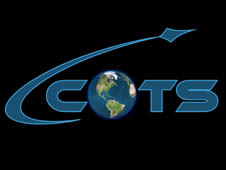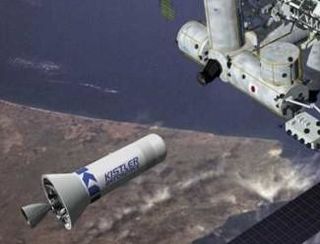
A spacecraft is a vehicle or machine designed to fly in outer space. A type of artificial satellite, spacecraft are used for a variety of purposes, including communications, Earth observation, meteorology, navigation, space colonization, planetary exploration, and transportation of humans and cargo. All spacecraft except single-stage-to-orbit vehicles cannot get into space on their own, and require a launch vehicle.

A reusable launch vehicle have parts that can be recovered and reflown, while carrying payloads from the surface to outer space. Rocket stages are the most common launch vehicle parts aimed for reuse. Smaller parts such as rocket engines and boosters can also be reused, though reusable spacecraft may be launched on top of an expendable launch vehicle. Reusable launch vehicles do not need to make these parts for each launch, therefore reducing its launch cost significantly. However, these benefits are diminished by the cost of recovery and refurbishment.

A spaceplane is a vehicle that can fly and glide like an aircraft in Earth's atmosphere and maneuver like a spacecraft in outer space. To do so, spaceplanes must incorporate features of both aircraft and spacecraft. Orbital spaceplanes tend to be more similar to conventional spacecraft, while sub-orbital spaceplanes tend to be more similar to fixed-wing aircraft. All spaceplanes to date have been rocket-powered but then landed as unpowered gliders.

Private spaceflight is spaceflight or the development of spaceflight technology that is conducted and paid for by an entity other than a government agency.

The Rocketplane XP was a suborbital spaceplane design that was under development c. 2005 by Rocketplane Kistler. The vehicle was to be powered by two jet engines and a rocket engine, intended to enable it to reach suborbital space. The XP would have operated from existing spaceports in a manner consistent with established commercial aviation practices. Commercial flights were projected to begin in 2009. Rocketplane Global declared bankruptcy in mid-June 2010. Their assets were auctioned off in 2011.
Prior to June 2007, David Urie was Vice-President and Program Manager of Rocketplane Limited, Inc., where he managed the design of the Rocketplane XP.

PlanetSpace was a privately funded Chicago-based rocket and space travel project founded by Geoff Sheerin, CEO of the Canadian Arrow corporation. The owner is Dr. Chirinjeev Kathuria.
Pioneer Rocketplane was an aerospace design and development company intent on developing affordable manned space flight. The company is most famous for advocating a horizontal takeoff, turbo-jet and rocket propelled, aerial-refueled, rocket plane concept called the Pathfinder. The company still exists, but is no longer in operation. Pioneer's intellectual property is now owned by Rocketplane Limited, Inc., however Rocketplane Limited does not employ any of the principals of Pioneer Rocketplane.

The NK-33 and NK-43 are rocket engines designed and built in the late 1960s and early 1970s by the Kuznetsov Design Bureau. The NK designation is derived from the initials of chief designer Nikolay Kuznetsov. The NK-33 was among the most powerful LOX/RP-1 rocket engines when it was built, with a high specific impulse and low structural mass. They were intended for the ill-fated Soviet N1F moon rocket, which was an upgraded version of the N1. The NK-33A rocket engine is now used on the first stage of the Soyuz-2-1v launch vehicle. When the supply of the NK-33 engines are exhausted, Russia will supply the new RD-193 rocket engine. It used to be the first stage engines of the Antares 100 rocket series, although those engines are rebranded the AJ-26 and the newer Antares 200 and Antares 200+ rocket series uses the RD-181 for the first stage engines, which is a modified RD-191, but shares some properties like a single combustion chamber unlike the two combustion chambers used in the RD-180 of the Atlas V and the four combustion chambers used in the RD-170 of the Energia and Zenit rocket families, and the RD-107, RD-108, RD-117, and RD-118 rocket engines used on all of the variants of the Soyuz rocket.

Commercial Orbital Transportation Services (COTS) was a NASA program to coordinate the development of vehicles for the delivery of crew and cargo to the International Space Station by private companies. The program was announced on January 18, 2006 and successfully flew all cargo demonstration flights by September 2013, when the program ended.

Rocketplane Kistler (RpK) was a reusable launch system firm originally based in Oklahoma. It was formed in 2006 after Rocketplane Limited, Inc. acquired Kistler Aerospace. NASA announced that Rocketplane Kistler had been chosen to develop crew and cargo launch services. However, having missed financial milestones NASA terminated funding for the project. It filed for chapter 7 bankruptcy in 2010.

The Kistler K-1 was a two-stage, fully reusable launch vehicle design created by Kistler Aerospace. It was to accommodate a wide range of missions, including payload delivery to low Earth orbit (LEO), payload delivery to high-energy orbits with a K-1 Active Dispenser, technology demonstration flights, microgravity missions, and commercial cargo resupply, recovery, and reboost services for the International Space Station (ISS).
Andrews Space was founded in 1999 by Jason Andrews and Marian Joh to be a catalyst in the commercialization, exploration and development of space. Originally named Andrews Space & Technology, the company shortened its name in 2003 to Andrews Space. Over its life the company developed many unique technologies and space transportation architectures for the US Government and commercial customers. The company is now Spaceflight Systems, a subsidiary of Spaceflight Industries, Inc.

Cargo spacecraft are robotic spacecraft that are designed to carry cargo, possibly to support space stations' operation by transporting food, propellant and other supplies. This is different from a space probe, whose missions are to conduct scientific investigations.

Cygnus is an expendable American cargo spacecraft developed by Orbital Sciences Corporation and now manufactured and launched by Northrop Grumman Space Systems as part of NASA's Commercial Resupply Services (CRS) program. It is launched by Northrop Grumman's Antares rocket or ULA's Atlas V and is designed to transport supplies to the International Space Station (ISS) following the retirement of the American Space Shuttle. Since August 2000, ISS resupply missions have been regularly flown by the Russian Progress spacecraft, as well as by the European Automated Transfer Vehicle, and the Japanese H-II Transfer Vehicle. With the Cygnus spacecraft and the SpaceX Dragon, NASA seeks to increase its partnerships with domestic commercial aviation and aeronautics industry.

t/Space was an American aerospace company which participated in NASA's Commercial Orbital Transportation Services (COTS), and later, Commercial Crew Development (CCDev) programs for delivering cargo and crew to the International Space Station. The company was headquartered in Reston, Virginia.
Aircraft can have different ways to take off and land. Conventional airplanes accelerate along the ground until sufficient lift is generated for takeoff, and reverse the process to land. Some airplanes can take off at low speed, this being a short takeoff. Some aircraft such as helicopters and Harrier Jump Jets can take off and land vertically. Rockets also usually take off vertically, but some designs can land horizontally.
The DARPA XS-1 was an experimental spaceplane/booster with the planned capability to deliver small satellites into orbit for the U.S. Military. It was reported to be designed to be reusable as frequently as once a day, with a stated goal of doing so for 10 days straight. The XS-1 was intended to directly replace the first stage of a multistage rocket by taking off vertically and flying to hypersonic speed and high suborbital altitude, enabling one or more expendable upper stages to separate and deploy a payload into low Earth orbit. The XS-1 would then return to Earth, where it could ostensibly be serviced fast enough to repeat the process at least once every 24 hours.
Rocketplane Global Inc. is a reusable rocketplane aerospace design and development company headquartered in De Pere, Wisconsin.
Jason Andrews is an American space and technology entrepreneur. He co-founded with his wife Marian Joh, Andrews Space in 1999, founded Spaceflight Inc. in 2010, BlackSky Global LLC in 2013, and integrated all three entities together in 2015 under Spaceflight Industries.













